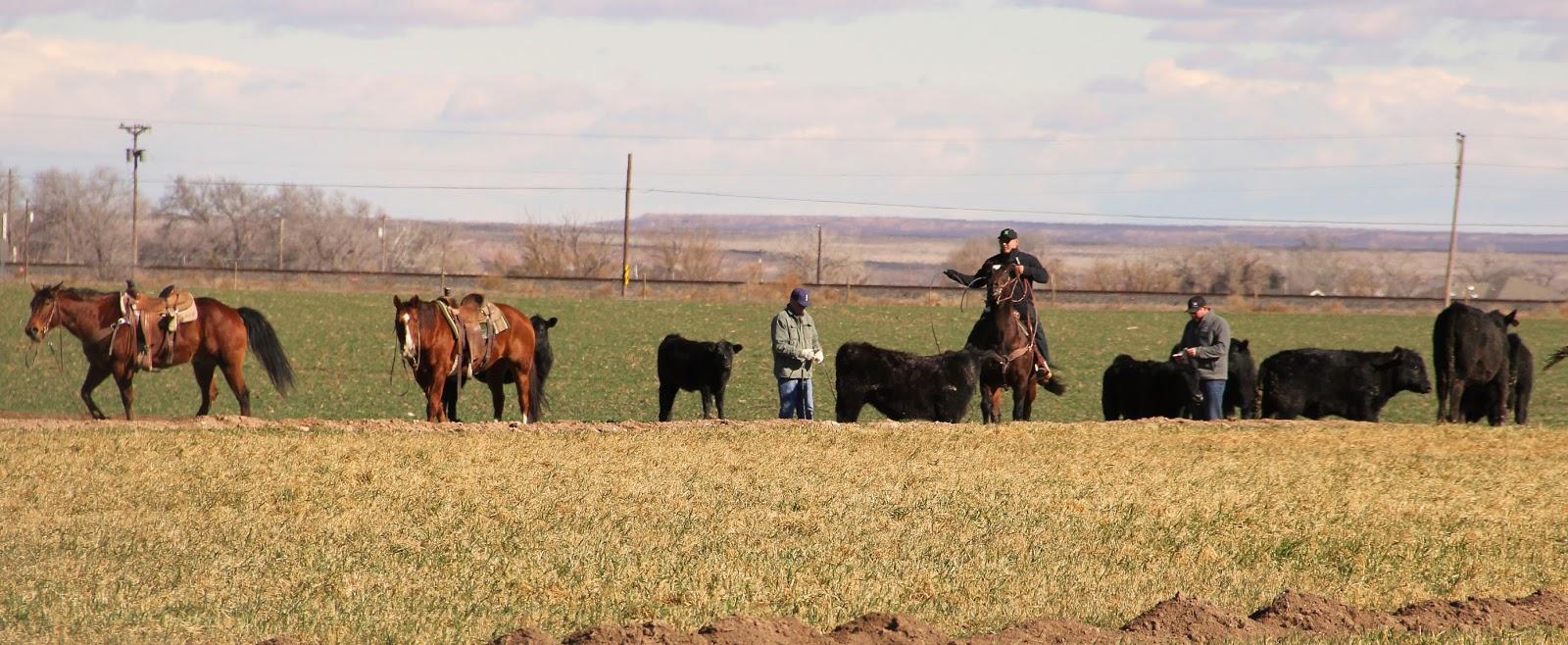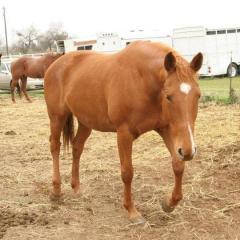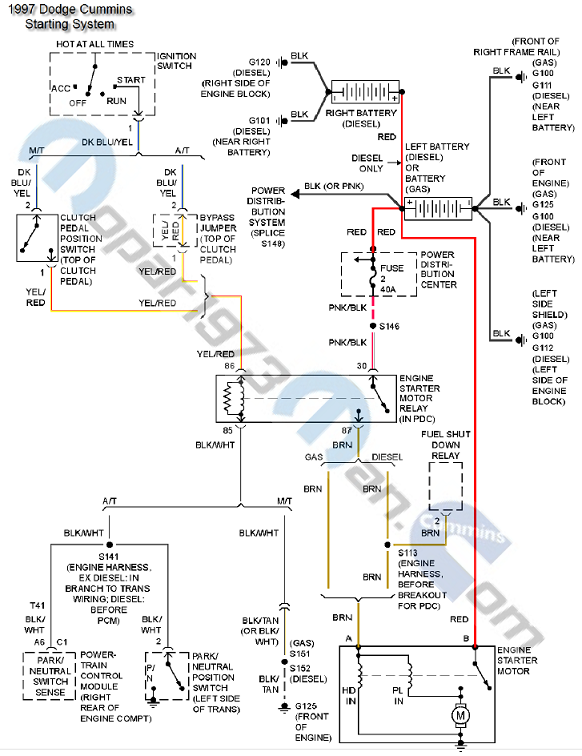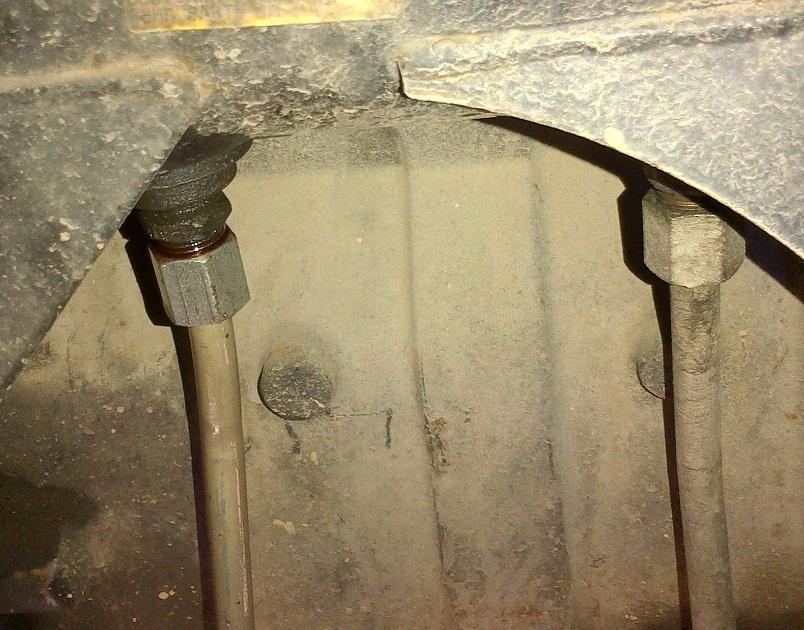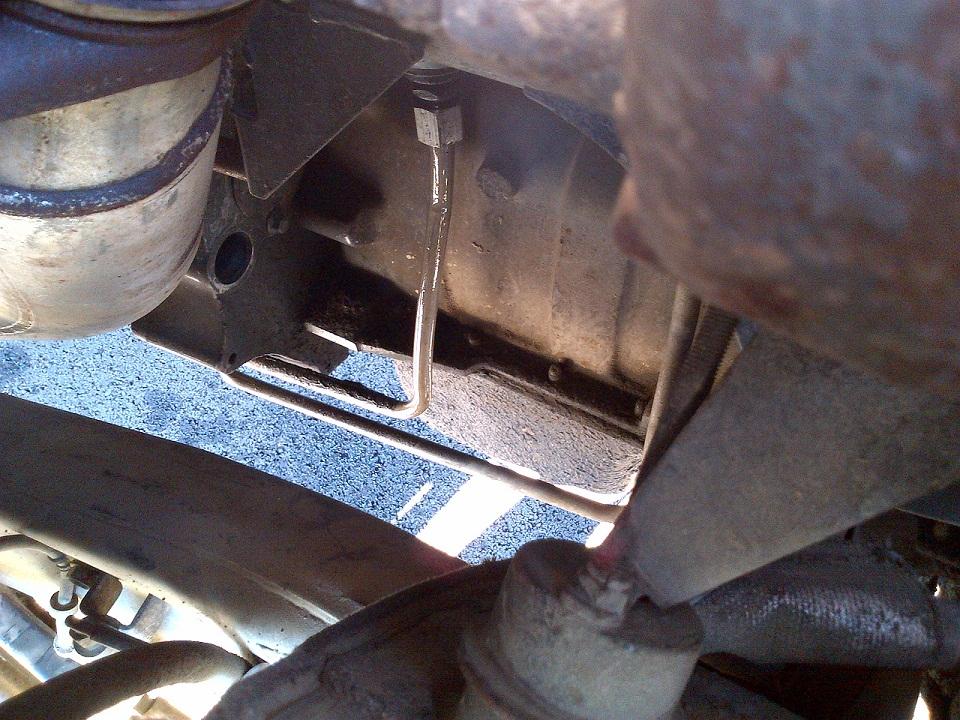I got this from tactransman @ dodgetalk.. http://www.dodgetalk.com/forums/showthread.php?t=197157
DIAGNOSIS CHARTS
The diagnosis charts provide additional reference when diagnosing a transmission fault. The charts provide general information on a variety of transmission, overdrive unit and converter clutch fault conditions.
Diagnosis Charts CONDITION ................. POSSIBLE CAUSES................... CORRECTION
HARSH ENGAGEMENT (FROM NEUTRAL TO DRIVE OR REVERSE)
1. Fluid Level Low. 1. Add Fluid
2. Throttle Linkage Mis-adjusted. 2. Adjust linkage - setting may be too long.
3. Mount and Driveline Bolts Loose. 3. Check engine mount, transmission mount, propeller shaft, rear spring to body bolts, rear control arms, crossmember and axle bolt torque. Tighten loose bolts and replace missing bolts.
4. U-Joint Worn/Broken. 4. Remove propeller shaft and replace U-Joint.
5. Axle Backlash Incorrect. 5. Check per Service Manual. Correct as needed.
6. Hydraulic Pressure Incorrect. 6. Check pressure. Remove, overhaul or adjust valve body as needed.
7. Band Mis-adjusted. 7. Adjust rear band.
8. Valve Body Check Balls Missing. 8. Inspect valve body for proper check ball installation.
9. Axle Pinion Flange Loose. 9. Replace nut and check pinion threads before installing new nut. Replace pinion gear if threads are damaged.
10. Clutch, band or planetary component damaged. 10. Remove, disassemble and repair transmission as necessary.
11. Converter Clutch Faulty. 11. Replace converter and flush cooler and line before installing new converter.
DELAYED ENGAGEMENT (FROM NEUTRAL TO DRIVE OR REVERSE)
1. Fluid Level Low. 1. Correct level and check for leaks.
2. Filter Clogged. 2. Change filter.
3. Gearshift Linkage Mis-adjusted. 3. Adjust linkage and repair linkage if worn or damaged.
4. Torque Converter Drain Back (Oil drains from torque converter into transmission sump). 4. If vehicle moves normally after 5 seconds after shifting into gear, no repair is necessary. If longer, inspect pump bushing for wear. Replace pump house.
5. Rear Band Mis-adjusted. 5. Adjust band.
6. Valve Body Filter Plugged. 6. Replace fluid and filter. If oil pan and old fluid were full of clutch disc material and/or metal particles, overhaul will be necessary.
7. Oil Pump Gears Worn/Damaged. 7. Remove transmission and replace oil pump.
8. Governor Circuit and Solenoid Valve Electrical Fault. 8. Test with DRB® scan tool and repair as required.
9. Hydraulic Pressure Incorrect. 9. Perform pressure test, remove transmission and repair as needed.
10. Reaction Shaft Seal Rings Worn/Broken. 10. Remove transmission, remove oil pump and replace seal rings.
11. Rear Clutch/Input Shaft, Rear Clutch Seal Rings Damaged. 11. Remove and disassemble transmission and repair as necessary.
12. Regulator Valve Stuck. 12. Clean.
13. Cooler Plugged. 13. Transfer case failure can plug cooler.
NO DRIVE RANGE (REVERSE OK)
1. Fluid Level Low. 1. Add fluid and check for leaks if drive is restored.
2. Gearshift Linkage/Cable Loose/Misadjusted. 2. Repair or replace linkage components.
3. Rear Clutch Burnt. 3. Remove and disassemble transmission and rear clutch and seals. Repair/replace worn or damaged parts as needed.
4. Valve Body Malfunction. 4. Remove and disassemble valve body. Replace assembly if any valves or bores are damaged.
5. Transmission Overrunning Clutch Broken. 5. Remove and disassemble transmission. Replace overrunning clutch.
6. Input Shaft Seal Rings Worn/Damaged. 6. Remove and disassemble transmission. Replace seal rings and any other worn or damaged parts.
7. Front Planetary Failed Broken. 7. Remove and repair.
NO DRIVE OR REVERSE (VEHICLE WILL NOT MOVE)
1. Fluid Level Low. 1. Add fluid and check for leaks if drive is restored.
2. Gearshift Linkage/Cable Loose/Misadjusted. 2. Inspect, adjust and reassemble linkage as needed. Replace worn/damaged parts.
3. U-Joint/Axle/Transfer Case Broken. 3. Perform preliminary inspection procedure for vehicle that will not move. Refer to procedure in diagnosis section.
4. Filter Plugged. 4. Remove and disassemble transmission. Repair or replace failed components as needed. Replace filter. If filter and fluid contained clutch material or metal particles, an overhaul may be necessary. Perform lube flow test. Flush oil. Replace cooler as necessary.
5. Oil Pump Damaged. 5. Perform pressure test to confirm low pressure. Replace pump body assembly if necessary.
6. Valve Body Malfunctioned. 6. Check and inspect valve body. Replace valve body (as assembly) if any valve or bore is damaged. Clean and reassemble correctly if all parts are in good condition.
7. Transmission Internal Component Damaged. 7. Remove and disassemble transmission. Repair or replace failed components as needed.
8. Park Sprag not Releasing - Check Stall Speed, Worn/Damaged/Stuck. 8. Remove, disassemble, repair.
9. Torque Converter Damage. 9. Inspect and replace as required.
SHIFTS DELAYED OR ERRATIC (SHIFTS ALSO HARSH AT TIMES)
1. Fluid Level Low/High. 1. Correct fluid level and check for leaks if low.
2. Fluid Filter Clogged. 2. Replace filter. If filter and fluid contained clutch material or metal particles, an overhaul may be necessary. Perform lube flow test.
3. Throttle Linkage Mis-adjusted. 3. Adjust linkage as described in service section.
4. Throttle Linkage Binding. 4. Check cable for binding. Check for return to closed throttle at transmission.
5. Gearshift Linkage/Cable Mis-adjusted. 5. Adjust linkage/cable as described in service section.
6. Clutch or Servo Failure. 6. Remove valve body and air test clutch, and band servo operation. Disassemble and repair transmission as needed.
7. Governor Circuit Electrical Fault. 7. Test using DRB® scan tool and repair as required.
8. Front Band Mis-adjusted. 8. Adjust band.
9. Pump Suction Passage Leak. 9. Check for excessive foam on dipstick after normal driving. Check for loose pump bolts, defective gasket. Replace pump assembly if needed.
NO REVERSE (D RANGES OK)
1. Gearshift Linkage/Cable Mis-adjusted/Damaged. 1. Repair or replace linkage parts as needed.
2. Park Sprag Sticking. 2. Replace overdrive annulus gear.
3. Rear Band Mis-adjusted/Worn. 3. Adjust band; replace.
4. Valve Body Malfunction. 4. Remove and service valve body. Replace valve body if any valves or valve bores are worn or damaged.
5. Rear Servo Malfunction. 5. Remove and disassemble transmission. Replace worn/damaged servo parts as necessary.
6. Direct Clutch in Overdrive Worn. 6. Disassemble overdrive. Replace worn or damaged parts.
7. Front Clutch Burnt. 7. Remove and disassemble transmission. Replace worn, damaged clutch parts as required.
HAS FIRST/REVERSE ONLY (NO 1-2 OR 2-3 UPSHIFT)
1. Governor Circuit Electrical Fault. 1. Test using DRB® scan tool and repair as required.
2. Valve Body Malfunction. 2. Repair stuck 1-2 shift valve or governor plug.
3. Front Servo/Kickdown Band Damaged/Burned. 3. Repair/replace.
MOVES IN 2ND OR 3RD GEAR, ABRUPTLY DOWNSHIFTS TO LOW
1. Valve Body Malfunction. 1. Remove, clean and inspect. Look for stuck 1-2 valve or governor plug.
NO LOW GEAR (MOVES IN 2ND OR 3RD GEAR ONLY)
1. Governor Circuit Electrical Fault. 1. Test with DRB® scan tool and repair as required.
2. Valve Body Malfunction. 2. Remove, clean and inspect. Look for sticking 1-2 shift valve, 2-3 shift valve, governor plug or broken springs.
3. Front Servo Piston Cocked in Bore. 3. Inspect servo and repair as required.
4. Front Band Linkage Malfunction 4. Inspect linkage and look for bind in linkage.
NO KICKDOWN OR NORMAL DOWNSHIFT
1. Throttle Linkage Mis-adjusted. 1. Adjust linkage.
2. Accelerator Pedal Travel Restricted. 2. Verify floor mat is not under pedal, repair worn accelerator cable or bent brackets.
3. Valve Body Hydraulic Pressures Too High or Too Low Due to Valve Body Malfunction or Incorrect Hydraulic Control Pressure Adjustments. 3. Perform hydraulic pressure tests to determine cause and repair as required. Correct valve body pressure adjustments as required.
4. Governor Circuit Electrical Fault. 4. Test with DRB® scan tool and repair as required.
5. Valve Body Malfunction. 5. Perform hydraulic pressure tests to determine cause and repair as required. Correct valve body pressure adjustments as required.
6. TPS Malfunction. 6. Replace sensor, check with DRB® scan tool.
7. PCM Malfunction. 7. Check with DRB® scan tool and replace if required.
8. Valve Body Malfunction. 8. Repair sticking 1-2, 2-3 shift valves, governor plugs, 3-4 solenoid, 3-4 shift valve, 3-4 timing valve.
STUCK IN LOW GEAR (WILL NOT UPSHIFT)
1. Throttle Linkage Mis-adjusted/Stuck. 1. Adjust linkage and repair linkage if worn or damaged. Check for binding cable or missing return spring.
2. Gearshift Linkage Mis-adjusted. 2. Adjust linkage and repair linkage if worn or damaged.
3. Governor Component Electrical Fault. 3. Check operating pressures and test with DRB® scan tool, repair faulty component.
4. Front Band Out of Adjustment. 4. Adjust Band.
5. Clutch or Servo Malfunction. 5. Air pressure check operation of clutches and bands. Repair faulty component.
CREEPS IN NEUTRAL
1. Gearshift Linkage Mis-adjusted. 1. Adjust linkage.
2. Rear Clutch Dragging/Warped. 2. Disassemble and repair.
3. Valve Body Malfunction. 3. Perform hydraulic pressure test to determine cause and repair as required.
BUZZING NOISE
1. Fluid Level Low 1. Add fluid and check for leaks.
2. Shift Cable Mis-assembled. 2. Route cable away from engine and bell housing.
3. Valve Body Mis-assembled. 3. Remove, disassemble, inspect valve body. Reassemble correctly if necessary. Replace assembly if valves or springs are damaged. Check for loose bolts or screws.
4. Pump Passages Leaking. 4. Check pump for porous casting, scores on mating surfaces and excess rotor clearance. Repair as required. Loose pump bolts.
5. Cooling System Cooler Plugged. 5. Flow check cooler circuit. Repair as needed.
6. Overrunning Clutch Damaged. 6. Replace clutch.
SLIPS IN REVERSE ONLY
1. Fluid Level Low. 1. Add fluid and check for leaks.
2. Gearshift Linkage Mis-adjusted. 2. Adjust linkage.
3. Rear Band Mis-adjusted. 3. Adjust band.
4. Rear Band Worn. 4. Replace as required.
5. Overdrive Direct Clutch Worn. 5. Disassemble overdrive. Repair as needed.
6. Hydraulic Pressure Too Low. 6. Perform hydraulic pressure tests to determine cause.
7. Rear Servo Leaking. 7. Air pressure check clutch-servo operation and repair as required.
8. Band Linkage Binding. 8. Inspect and repair as required.
SLIPS IN FORWARD DRIVE RANGES
1. Fluid Level Low. 1. Add fluid and check for leaks.
2. Fluid Foaming. 2. Check for high oil level, bad pump gasket or seals, dirt between pump halves and loose pump bolts. Replace pump if necessary.
3. Throttle Linkage Mis-adjusted. 3. Adjust linkage.
4. Gearshift Linkage Mis-adjusted. 4. Adjust linkage.
5. Rear Clutch Worn. 5. Inspect and replace as needed.
6. Low Hydraulic Pressure Due to Worn Pump, Incorrect Control Pressure Adjustments, Valve Body Warpage or Malfunction, Sticking, Leaking Seal Rings, Clutch Seals Leaking, Servo Leaks, Clogged Filter or Cooler Lines. 6. Perform hydraulic and air pressure tests to determine cause.
7. Rear Clutch Malfunction, Leaking Seals or Worn Plates. 7. Air pressure check clutch-servo operation and repair as required.
8. Overrunning Clutch Worn, Not Holding (Slips in 1 Only). 8. Replace Clutch.
SLIPS IN LOW GEAR "D" ONLY, BUT NOT IN MANUAL 1 POSITION
Overrunning Clutch Faulty. Replace overrunning clutch.
GROWLING, GRATING OR SCRAPING NOISES
1. Drive Plate Broken. 1. Replace.
2. Torque Converter Bolts Hitting Dust Shield. 2. Dust shield bent. Replace or repair.
3. Planetary Gear Set Broken/Seized. 3. Check for debris in oil pan and repair as required.
4. Overrunning Clutch Worn/Broken. 4. Inspect and check for debris in oil pan. Repair as required.
5. Oil Pump Components Scored/Binding. 5. Remove, inspect and repair as required.
6. Output Shaft Bearing or Bushing Damaged. 6. Remove, inspect and repair as required.
7. Clutch Operation Faulty. 7. Perform air pressure check and repair as required.
8. Front and Rear Bands Mis-adjusted. 8. Adjust bands.
DRAGS OR LOCKS UP
1. Fluid Level Low. 1. Check and adjust level.
2. Clutch Dragging/Failed 2. Air pressure check clutch operation and repair as required.
3. Front or Rear Band Mis-adjusted. 3. Adjust bands.
4. Case Leaks Internally. 4. Check for leakage between passages in case.
5. Servo Band or Linkage Malfunction. 5. Air pressure check servo operation and repair as required.
6. Overrunning Clutch Worn. 6. Remove and inspect clutch. Repair as required.
7. Planetary Gears Broken. 7. Remove, inspect and repair as required (look for debris in oil pan).
8. Converter Clutch Dragging. 8. Check for plugged cooler. Perform flow check. Inspect pump for excessive side clearance. Replace pump as required.
NO 4-3 DOWNSHIFT
1. Circuit Wiring and/or Connectors Shorted. 1. Test wiring and connectors with test lamp and volt/ohmmeter. Repair wiring as necessary. Replace connectors and/or harnesses as required.
2. PCM Malfunction. 2. Check PCM operation with DRB® scan tool. Replace PCM only if faulty.
3. TPS Malfunction 3. Check TPS with DRB® scan tool at PCM.
4. Lockup Solenoid Not Venting. 4. Remove valve body and replace solenoid assembly if plugged or shorted.
5. Overdrive Solenoid Not Venting. 5. Remove valve body and replace solenoid if plugged or shorted.
6. Valve Body Valve Sticking. 6. Repair stuck 3-4 shift valve or lockup timing valve.
NO 4-3 DOWNSHIFT WHEN CONTROL SWITCH IS TURNED OFF
1. Control Switch Open/Shorted. 1. Test and replace switch if faulty.
2. Overdrive Solenoid Connector Shorted. 2. Test solenoids and replace if seized or shorted.
3. PCM Malfunction. 3. Test with DRB® scan tool. Replace PCM if faulty.
4. Valve Body Stuck Valves. 4. Repair stuck 3-4, lockup or lockup timing valve.
CLUNK NOISE FROM DRIVELINE ON CLOSED THROTTLE 4-3 DOWNSHIFT
1. Transmission Fluid Low. 1. Add Fluid.
2. Throttle Cable Mis-adjusted. 2. Adjust cable.
3. Overdrive Clutch Select Spacer Wrong Spacer. 3. Replace overdrive piston thrust plate spacer.
3-4 UPSHIFT OCCURS IMMEDIATELY AFTER 2-3 SHIFT
1. Overdrive Solenoid Connector or Wiring Shorted. 1. Test connector and wiring for loose connections, shorts or ground and repair as needed.
2. TPS Malfunction. 2. Test TPS and replace as necessary. Check with DRB® scan tool.
3. PCM Malfunction. 3. Test PCM with DRB® scan tool and replace controller if faulty.
4. Overdrive Solenoid Malfunction. 4. Replace solenoid.
5. Valve Body Malfunction. 5. Remove, disassemble, clean and inspect valve body components. Make sure all valves and plugs slide freely in bores. Polish valves with crocus cloth if needed.
WHINE/NOISE RELATED TO ENGINE SPEED
1. Fluid Level Low. 1. Add fluid and check for leaks.
2. Shift Cable Incorrect Routing. 2. Check shift cable for correct routing. Should not touch engine or bell housing.
NO 3-4 UPSHIFT
1. O/D Switch In OFF Position.
1. Turn control switch to ON position.
2. Overdrive Circuit Fuse Blown. 2. Replace fuse. Determine why fuse failed and repair as necessary (i.e., shorts or grounds in circuit).
3. O/D Switch Wire Shorted/Open Cut. 3. Check wires/connections with 12V test lamp and voltmeter. Repair damaged or loose wire/connection as necessary.
4. Distance or Coolant Sensor Malfunction. 4. Check with DRB® scan tool and repair or replace as necessary.
5. TPS Malfunction. 5. Check with DRB® scan tool and replace if necessary.
6. Neutral Sense to PCM Wire Shorted/Cut. 6. Test switch/sensor as described in service section and replace if necessary. Engine no start.
7. PCM Malfunction. 7. Check with DRB® scan tool and replace if necessary.
8. Overdrive Solenoid Shorted/Open. 8. Replace solenoid if shorted or open and repair loose or damaged wires (DRB® scan tool).
9. Solenoid Feed Orifice in Valve Body Blocked. 9. Remove, disassemble, and clean valve body thoroughly. Check feed orifice.
10. Overdrive Clutch Failed. 10. Disassemble overdrive and repair as needed.
11. Hydraulic Pressure Low. 11. Pressure test transmission to determine cause.
12. Valve Body Valve Stuck. 12. Repair stuck 3-4 shift valve, 3-4 timing valve.
13. O/D Piston Incorrect Spacer. 13. Remove unit, check end play and install correct spacer.
14. Overdrive Piston Seal Failure. 14. Replace both seals.
15. O/D Check Valve/Orifice Failed. 15. Check for free movement and secure assembly (in piston retainer). Check ball bleed orifice.
SLIPS IN OVERDRIVE FOURTH GEAR
1. Fluid Level Low. 1. Add fluid and check for leaks.
2. Overdrive Clutch Pack Worn. 2. Remove overdrive unit and rebuild clutch pack.
3. Overdrive Piston Retainer Bleed Orifice Blown Out. 3. Disassemble transmission, remove retainer and replace orifice.
4. Overdrive Piston or Seal Malfunction. 4. Remove overdrive unit. Replace seals if worn. Replace piston if damaged. If piston retainer is damaged, remove and disassemble the transmission.
5. 3-4 Shift Valve, Timing Valve or Accumulator Malfunction. 5. Remove and overhaul valve body. Replace accumulator seals. Make sure all valves operate freely in bores and do not bind or stick. Make sure valve body screws are correctly tightened and separator plates are properly positioned.
6. Overdrive Unit Thrust Bearing Failure. 6. Disassemble overdrive unit and replace thrust bearing (NO. 1 thrust bearing is between overdrive piston and clutch hub; NO. 2 thrust bearing is between the planetary gear and the direct clutch spring plate; NO. 3 thrust bearing is between overrunning clutch hub and output shaft).
7. O/D Check Valve/Bleed Orifice Failure. 7. Check for function/secure orifice insert in O/D piston retainer.
DELAYED 3-4 UPSHIFT (SLOW TO ENGAGE)
1. Fluid Level Low. 1. Add fluid and check for leaks.
2. Throttle Valve Cable Mis-adjusted. 2. Adjust throttle valve cable.
3. Overdrive Clutch Pack Worn/Burnt. 3. Remove unit and rebuild clutch pack.
4. TPS Faulty. 4. Test with DRB® scan tool and replace as necessary
5. Overdrive Clutch Bleed Orifice Plugged. 5. Disassemble transmission and replace orifice.
6. Overdrive Solenoid or Wiring Shorted/Open. 6. Test solenoid and check wiring for loose/corroded connections or shorts/grounds. Replace solenoid if faulty and repair wiring if necessary.
7. Overdrive Excess Clearance. 7. Remove unit. Measure end play and select proper spacer.
8. O/D Check Valve Missing or Stuck. 8. Check for presence of check valve. Repair or replace as required
.
TORQUE CONVERTER LOCKS UP IN SECOND AND/OR THIRD GEAR
Lockup Solenoid, Relay or Wiring Shorted/Open. Test solenoid, relay and wiring for continuity, shorts or grounds. Replace solenoid and relay if faulty. Repair wiring and connectors as necessary.
HARSH 1-2, 2-3, 3-4 OR 3-2 SHIFTS
Lockup Solenoid Malfunction. Remove valve body and replace solenoid assembly.
NO START IN PARK OR NEUTRAL
1. Gearshift Linkage/Cable Mis-adjusted. 1. Adjust linkage/cable.
2. Neutral Sense Wire Open/Cut. 2. Check continuity with test lamp. Repair as required.
3. Park/Neutral Switch, or Transmission Range Sensor Faulty. 3. Refer to service section for test and replacement procedure.
4. Park/Neutral Switch, or Transmission Range Sensor Connection Faulty. 4. Connectors spread open. Repair.
5. Valve Body Manual Lever Assembly Bent/Worn/Broken. 5. Inspect lever assembly and replace if damaged.
NO REVERSE (OR SLIPS IN REVERSE)
1. Direct Clutch Pack (front clutch) Worn. 1. Disassemble unit and rebuild clutch pack.
2. Rear Band Mis-adjusted. 2. Adjust band.
3. Front Clutch Malfunctioned/Burned. 3. Air-pressure test clutch operation. Remove and rebuild if necessary.
4. Overdrive Thrust Bearing Failure. 4. Disassemble geartrain and replace bearings.
5. Direct Clutch Spring Collapsed/Broken. 5. Remove and disassemble unit. Check clutch position and replace spring.
OIL LEAKS.
1. Fluid Lines and Fittings Loose/Leaks/Damaged. 1. Tighten fittings. If leaks persist, replace fittings and lines if necessary.
2. Fill Tube (where tube enters case) Leaks/Damaged. 2. Replace tube seal. Inspect tube for cracks in fill tube.
3. Pressure Port Plug Loose Loose/Damaged. 3. Tighten to correct torque. Replace plug or reseal if leak persists.
4. Pan Gasket Leaks. 4. Tighten pan screws (150 in. lbs.). If leaks persist, replace gasket.
5. Valve Body Manual Lever Shaft Seal Leaks/Worn. 5. Replace shaft seal.
6. Rear Bearing Access Plate Leaks. 6. Replace gasket. Tighten screws.
7. Gasket Damaged or Bolts are Loose. 7. Replace bolts or gasket or tighten both.
8. Adapter/Extension Gasket Damaged Leaks/Damaged. 8. Replace gasket.
9. Park/Neutral Switch, or Transmission Range Sensor Leaks/Damaged. 9. Replace switch and gasket.
10. Converter Housing Area Leaks. 10. Check for leaks at seal caused by worn seal or burr on converter hub (cutting seal), worn bushing, missing oil return, oil in front pump housing or hole plugged. Check for leaks past O-ring seal on pump or past pump-to-case bolts; pump housing porous, oil coming out vent due to overfill or leak past front band shaft access plug.
11. Pump Seal Leaks/Worn/Damaged. 11. Replace seal.
12. Torque Converter Weld Leak/Cracked Hub. 12. Replace converter.
13. Case Porosity Leaks. 13. Replace case.
NOISY OPERATION IN FOURTH GEAR ONLY
1. Overdrive Clutch Discs, Plates or Snap Rings Damaged. 1. Remove unit and rebuild clutch pack.
2. Overdrive Piston or Planetary Thrust Bearing Damaged. 2. Remove and disassemble unit. Replace either thrust bearing if damaged.
3. Output Shaft Bearings Scored/Damaged. 3. Remove and disassemble unit. Replace either bearing if damaged.
4. Planetary Gears Worn/Chipped. 4. Remove and overhaul overdrive unit.
5. Overdrive Unit Overrunning Clutch Rollers Worn/Scored. 5. Remove and overhaul overdrive unit.
